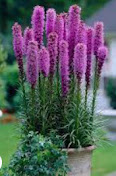Sounds like something we should do occasionally just to make sure our brains receive some stimulation. Consider it a mental health type of COVID-19 stimulus package. It may have benefits money can't buy.
Every year I have trouble putting together attractive, colorful, eye-catching container plantings. The June issue of Fine Gardening features an article titled "Spice up your containers with Herbs" I immediately skipped to page 60 and decided that might be fun to mix things up a bit.
Sarah Partyka, owner of a garden center in Rhode Island offered six container designs incorporating at least one herb in each planting. The containers have catchy names like Mojitos Anyone? Gourmet Garnishes and Pesto All Summer are just several of the names.
 |
| Liatris spicata |
The Gourmet Garnish container features borage for the cucumber flavored leaves, pineapple sage for minced leaves that add a fruity essence to fruit salads and marinades. Heuchera variety for a dark leaf color and hibiscus for height in the back of the container. The hibiscus probably wouldn't be a plant we would find in our local nurseries--but you never know. The design would require a plant with height.
 |
| Basil |
 |
| Dipladenia |
The secret to success in a herbal-themed container would be to include a variety of leaf shapes, leaf texture and color. Growth height should vary. Consider the guidelines we use for traditional container planting: thriller, filler, spiller.
The reason I like this planting concept is that it allows for a more controlled quantity. When I come across a recipe that requires a few mint leaves, I don't want to run to the store and purchase the fresh herb packet. Nor do I want to plant a few mint plants knowing what will happen in a few years--I'll curse the day I planted the first one without any barriers. Many gardeners won't plant borage because of its prolific growth, but they do like the cucumber scented flowers as a salad garnish. One plant might satisfy those taste buds .
 |
| Borage |
In reviewing the plants I learned that the rue in addition to being toxic, also inhibits growth of some plants of which basil is one of them. Learning that surprised me that it was included with the basil.
I think this a great twist on the traditional container planting and I plan on giving it a try. The hard part will will be finding a container suitable for 4-5 plants. The exciting part will be finding the plants. Give it a try!
Mark your calendar for Gardening: Get Good at It "Happy Apple Project" segment on Tuesday April 20 on KPOV 88.9 FM between 9-9:30 am



No comments:
Post a Comment
Let us know what you think of Gardening in Central Oregon.